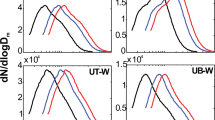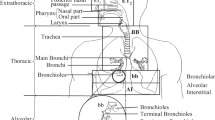Abstract
The objective of the current study was to determine the growth and deposition of hygroscopic aerosol particles in the human respiratory tract. A hygroscopic particle growth methodology was incorporated into an existing particle dosimetry model (Exposure Dose Model 2, ExDoM2) using the κ-Köhler theory, the International Commission on Radiological Protection (ICRP) formulation for hygroscopic growth and mathematical formulations for taking into account the residence time, the influence of hygroscopicity on the particle’s density, and hygroscopic growth at 99.5% relative humidity. In order to validate ExDoM2, the results of the model were compared with experimental total deposition data for NaCl particles. The incorporation of the hygroscopic growth resulted in predictions closer to the experimental data than to model results without the use of a hygroscopic model formulation. The hygroscopicity plays a more significant role in the lower regions (tracheobronchial (TB) and alveolar-interstitial (AI) regions) of the respiratory tract. In particular, the hygroscopicity of NaCl particles decreases the deposition in the AI region for particles in the size range 0.03 μm ≤ aerodynamic diameter (dae) ≤ 0.2 μm while for the size range 0.3 μm ≤ dae ≤ 3 μm, the hygroscopicity increases the deposition in the AI region. In addition, it is observed that the deposition of (NH4)2SO4 and NH4NO3 particles with dae ≥ 0.30 μm is higher when the hygroscopic properties of the particles are taken into consideration. However, the particle deposition in the range 0.02 μm ≤ dae ≤ 0.25 μm is decreased due to hygroscopicity.





Similar content being viewed by others
References
Aleksandropoulou V, Lazaridis M (2013) Development and application of a model (ExDoM) for calculating the respiratory tract dose and retention of particles under variable exposure conditions. Air Qual Atmos Health 6:13–26
Anselm A, Heibel T, Gebhart J, Ferron G (1990) “In vivo”-studies of growth factors of sodium chloride particles in the human respiratory tract. J Aerosol Sci 21:427–430
Asgharian BA (2004) A model of deposition of hygroscopic particles in the human lung. Aerosol Sci Technol 38:938–947
Blanchard JD, Willeke K (1984) Total deposition of ultrafine sodium chloride particles in human lungs. J Appl Physiol 57:1850–1856
Buonanno G, Giovinco G, Morawska L, Stabile L (2015) Lung cancer risk of airborne particles for Italian population. Environ Res 142:443–451
Carrico CM, Petters MD, Kreidenweis SM, Collett JL, Engling G, Malm WC (2008) Aerosol hygroscopicity and cloud droplet activation of extracts of filters from biomass burning experiments. J Geophys Res Atmos 113. https://doi.org/10.1029/2007JD009274
Chalvatzaki E, Lazaridis M (2015) Development and application of a dosimetry model (ExDoM2) for calculating internal dose of specific particle bound metals in the human body. Inhal Toxicol 27(6):308–320
Ferron G (1977) The size of soluble aerosol particles as a function of the humidity of the air. Application to the human respiratory tract. J Aerosol Sci 8:251–267
Ferron GA, Haider B, Kreyling WG (1988a) Inhalation of salt aerosol particles I. Estimation of the temperature and relative humidity in the upper human airways. J Aerosol Sci 19:343–363
Ferron GA, Kreyling WG, Haider B (1988b) Inhalation of salt aerosol particles II. Growth and deposition in the human respiratory tract. J Aerosol Sci 19:611–631
Ferron GA, Karg E, Peter JE (1993) Estimation of deposition of polydisperse hygroscopic aerosols in the human respiratory tract. J Aerosol Sci 24(5):655–670
Ferron GA, Karg E, Busch B, Heyder J (2005) Ambient particles at an urban, semi-urban and rural site in Central Europe: hygroscopic properties. Atmos Environ 39:343–352
Gebhart J, Heigwer G, Heyder J, Roth C, Stahlhofen W (1998) The use of light scattering photometry in aerosol medicine. J Aerosol Med 1:89–112
Good N, Topping DO, Allan JD, Flynn M, Fuentes E, Irwin M, Williams PI, Coe H, McFiggans G (2010) Consistency between parameterisations of aerosol hygroscopicity and CCN activity during the RHaMBLe discovery cruise. Atmos Chem Phys 10:3189–3203
Haddrell AE, Davies JF, Miles REH, Reid JP, Dailey LA, Murnane D (2014) Dynamics of aerosol size during inhalation: hygroscopic growth of commercial nebulizer formulations. Int J Pharm 463(1):50–61
Haddrell AE, Davies JF, Reid JP (2015) Dynamics of particle size on inhalation of environmental aerosol and impact on deposition fraction. Environ Sci Technol 49:14512–14521
Hansen JE, Ampaya EP (1975) Human air space shapes, sizes, areas, and volumes. J Appl Physiol 38(6):990–995
Hinds WC (1999) Aerosol technology: properties, behavior and measurement of airborne particles, 2nd edn. John Wiley & Sons Inc, Hoboken
Hofmann W, Koblinger L (1990) Monte Carlo modeling of aerosol deposition in human lungs. Part II: deposition fractions and their sensitivity to parameter variations. J Aerosol Sci 21:674–688
Hussain M, Madl P, Khan A (2011) Lung deposition predictions of airborne particles and the emergence of contemporary diseases part-I. Health 2(2):51–59
ICRP (1994) Human respiratory tract model for radiological protection. ICRP publication 66. Ann. ICRP 24 (1-3). Pergamon Press, Oxford
ICRP (2015) Occupational intakes of radionuclides: part 1. ICRP Publication 130. Ann. ICRP 44 (2)
James AC (1988) Lung dosimetry. In: Nazaroff WW, Nero AV (eds) Radon and its decay products in indoor air. John Wiley and Sons, Inc., New York, pp 259–309
Koblinger L, Hofmann W (1990) Monte Carlo modeling of aerosol deposition in human lungs. Part I: simulation of particle transport in a stochastic lung structure. J Aerosol Sci 21:661–674
Köhler H (1936) The nucleus in and the growth of hygroscopic droplets. Trans Faraday Soc 32:1152–1161
Kreidenweis SM, Koehler K, DeMott PJ, Prenni AJ, Carrico C, Ervens B (2005) Water activity and activation diameters from Hygroscopicity data - part I: theory and application to inorganic salts. Atmos Chem Phys 5:1357–1370
Kristensson A, Rissler J, Löndahl J, Johansson C, Swietlicki E (2013) Size-resolved respiratory tract deposition of sub-micrometer aerosol particles n a residential area with wintertime wood combustion. Aerosol Air Qual Res 13:24–35
Liu HJ, Zhao CS, Nekat B, Ma N, Wiedensohler A, van Pinxteren D, Spindler G, Müller K, Herrmann H (2014) Aerosol hygroscopicity derived from size-segregated chemical composition and its parameterization in the North China plain. Atmos Chem Phys 14:2525–2539
Liu YC, Wu ZJ, Tan TY, Wang YJ, Qin YH, Zheng J, Li MR, Hu M (2016) Estimation of the PM2.5 effective hygroscopic parameter and water content based on particle chemical composition: methodology and case study. Sci China Earth Sci 59:1683–1691
Löndahl J, Massling A, Swietlicki E, Bräuner EV, Ketzel M, Pagels J, Loft S (2009) Experimentally determined human respiratory tract deposition of airborne particles at a busy street. Environ. Sci Technol 43:4659–4664
Markelj J, Madronich S, Pompe M (2016) Modeling of hygroscopicity parameter kappa of organic aerosols using quantitative structure-property relationships. J Atmos Chem 74:357–376. https://doi.org/10.1007/s10874-016-9347-3
Martonen TB, Bell KA, Phalen RF, Wilson AF, Ho A (1982) Growth rate measurements and deposition modeling of hygroscopic aerosols in human tracheobronchial models. Ann Occup Hyg 26:93–108
Petters MD, Kreidenweis SM (2007) A single parameter representation of hygroscopic growth and cloud condensation nucleus activity. Atmos Chem Phys 7:1961–1971
Phalen RF, Oldham MJ, Beaucage CB, Crocker TT, Mortensen JD (1985) Postnatal enlargement of human tracheo-bronchial airways and implications for particle deposition. Anat Rec 212(4):368–380
Rissler J (2005) Hygroscopic properties of aerosols from open-air burning and controlled combustion of biomass, Ph.D. thesis, Div of Nucl Phys Dep of Phys, Lund Univ, Lund, Sweden
Rissler J, Svenningsson B, Fors EO, Bilde M, Swietlicki E (2010) An evaluation and comparison of cloud condensation nucleus activity models: predicting particle critical saturation from growth at subsaturation. J Geophys Res Atmos 115. https://doi.org/10.1029/2010JD014391
Sánchez-Soberón F, Mari M, Kumar V, Rovira J, Nadal M, Schuhmacher M (2015) An approach to assess the particulate matter exposure for the population living around a cement plant: modelling indoor air and particle deposition in the respiratory tract. Environ Res 143:10–18
Schum GM, Yeh HC (1980) Models of human lung airways and their application to inhaled particle deposition. Bull Math Biol 42:461–480
Snider G, Weagle CL, Murdymootoo KK, Ring A, Ritchie Y, Stone E, Walsh A, Akoshile C, Anh NX, Balasubramanian R, Brook J, Qonitan FD, Dong J, Griffith D, He K, Holben BN, Kahn R, Lagrosas N, Lestari P, Ma Z, Misra A, Norford LK, Quel EJ, Salam A, Schichtel B, Segev L, Tripathi S, Wang C, Yu C, Zhang Q, Zhang Y, Brauer M, Cohen A, Gibson MD, Liu Y, Martins JV, Rudich Y, Martin RV (2016) Variation in global chemical composition of PM2:5: emerging results from SPARTAN. Atmos Chem Phys 16:9629–9653
Tu KW, Knutson EO (1984) Total deposition of ultrafine hydrophobic and hygroscopic aerosols in the human respiratory system. Aerosol Sci Technol 3:453–466
Varghese SK, Gangamma S (2006) Particle deposition in human respiratory tract: effect of water-soluble fraction. Aerosol Air Qual Res 6(4):360–379
Vu TV, Delgado-Saborit JM, Harrison RM (2015) A review of hygroscopic growth factors of submicron aerosols from different sources and its implication for calculation of lung deposition efficiency of ambient aerosols. Air Qual Atmos Health 8:429–440
Vu TV, Ondracek J, Zdímal V, Schwarz J, Delgado-Saborit JM, Harrison RM (2017) Physical properties and lung deposition of particles emitted from five major indoor sources. Air Qual Atmos Health 10:1–14. https://doi.org/10.1007/s11869-016-0424-1
Weibel ER (1963) Morphometry of the human lung. Academic Press, New York
Winkler-Heil R, Ferron G, Hofmann W (2014) Calculation of hygroscopic particle deposition in the human lung. Inhal Toxicol 26(3):193–206
Wu ZJ, Poulain L, Henning S, Dieckmann K, Birmili W, Merkel M, van Pinxteren D, Spindler G, Müller K, Strat-mann F, Herrmann H, Wiedensohler A (2013) Relating particle hygroscopicity and CCN activity to chemical composition during the HCCT-2010 field campaign. Atmos Chem Phys 13:7983–7996
Yan Y, Fu P, Jing B, Peng C, Boreddy SKR, Yang F, Wei L, Sun Y, Wang Z, Ge M (2017) Hygroscopic behavior of water-soluble matter in marine aerosols over the East China Sea. Sci Total Environ 578:307–316
Yeh HC, Schum GM (1980) Models of human lung airways and their application to inhaled particle deposition. Bull Math Biol 42:461–480
Youn JS, Csavina J, Rine KP, Shingler T, Taylor MP, Sáez AE, Betterton EA, Sorooshian A (2016) Hygroscopic properties and respiratory system deposition behavior of particulate matter emitted by mining and smelting operations. Environ Sci Technol 50:11706–11713
Yu CP, Diu CK (1982) A comparative study of aerosol deposition in different lung models. Am Ind Hyg Assoc J 43:54–65
Acknowledgements
This work was supported by the European Union’s LIFE Programme in the framework of the Index-Air LIFE15 ENV/PT/000674 project.
Author information
Authors and Affiliations
Corresponding author
Rights and permissions
About this article
Cite this article
Chalvatzaki, E., Lazaridis, M. Α dosimetry model of hygroscopic particle growth in the human respiratory tract. Air Qual Atmos Health 11, 471–482 (2018). https://doi.org/10.1007/s11869-018-0555-7
Received:
Accepted:
Published:
Issue Date:
DOI: https://doi.org/10.1007/s11869-018-0555-7




